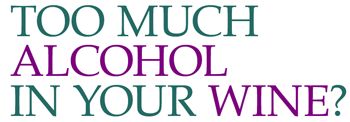TOO MUCH ALCOHOL IN YOUR WINE?
There may be a growing resistance to wines with alcohol contents above 14 percent, perhaps in reaction to the growing number of wines of that strength. Unfortunately for the objectors, such wines are likely to become more and more common as the world warms. The venerable Michael Broadbent has led in sounding a recurrent drumbeat in his monthly columns in decanter magazine.
Broadbent, by virtue of his immense tasting experience, has deservedly become a monument in winedom, and monuments, especially when still vital in their mid-80s, are wont to issue decrees. He decries wines of 14-plus, shying away from the labels like a skittish foal. He complains that they are “too powerful”, “too heady”, that the two generous glasses he drinks with lunch “can be knockout drops.” This theme has become, by his own admission, his “hobbyhorse”. He appears to favor French wines, which sometimes have had trouble ripening enough to evolve sufficient alcohol, to those of the New World, even complaining at the number on the label of a wine as delicious and well integrated as that of Napa’s Shafer Vineyards. Mr. Broadbent drinks wine with every meal. He seems to enjoy a “pre-breakfast Buck’s Fizz,” and certainly is no stranger to Port. I don’t know whether he indulges in the once customary English elevenses, low or high tea, or nightcaps. If so, no wonder he is smiling. I do know that he is conscious of moderation. I respect and admire Mr. Broadbent. My wife and I once spent an evening dining with him, and I can testify to his charm and intelligence. But, I believe, he should not condemn a wine because of a number on its label. If a wine is good, but the alcohol levels daunting, one should adjust one’s intake.
My rough calculations, assuming consumption of a half bottle at lunch, conclude that the difference in alcohol between 13-percent and 14.5-percent wines is trivial, equivalent to drinking just over an extra ounce of the 13-percent wine (or about 4 grams of alcohol). The effects on a given individual will vary according to rate of consumption, whether or not one eats, whether one is innocent of alcohol or experienced, the sex of the drinker, plus incalculable idiosyncratic factors. The healthiest use of alcohol is moderate, regular consumption with food. The least salubrious are none at all and, especially, immoderate quantities in binges.
Acceptability of alcohol in wine is dependent upon its balance or harmony with the other elements. Each element should be in its Goldilocks zone: not too much, not too little, but just right; and in balance with one another. I am no advocate of overripe, over-extracted, overly alcoholic and tannic wines lacking in acidity and grace, wines whose hemlines nearly meet their necklines. I would reject high alcohol just for the sake of high alcohol. The harmony may be played as a chamber work or by full orchestra or as grand opera. If the players – fruit, alcohol, acidity, phenolics – are in balance, the wine will sing.

